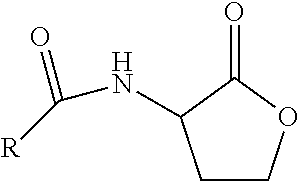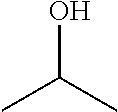Biofilm disruptive compositions
a biofilm and composition technology, applied in the direction of biocide, drug composition, antibacterial agent, etc., can solve the problems of inability to remove biofilms, damage to equipment, cooling systems, etc., and achieve the effect of facilitating the reduction and/or eradication of bacteria
- Summary
- Abstract
- Description
- Claims
- Application Information
AI Technical Summary
Benefits of technology
Problems solved by technology
Method used
Image
Examples
example 1
Screening of Biofilm Disruptive Agents
[0108]Formulations containing unsaturated long chain alcohols as the biofilm disruptive agents were prepared according to the following formula:
Raw material% (w / v)Water77.75Ethanol (190 proof)22Unsaturated long chain alcohol0.05Pluronic F-1270.2
[0109]Separate formulations were prepared from the above ingredients with each formulation containing one of the unsaturated long chain alcohols in Table 1. The formulations were then tested as indicated below. In addition, the following negative control without any unsaturated long chain alcohol was also prepared.
Raw material% (w / v)Water77.80Ethanol (190 proof)22Pluronic F-1270.2
[0110]A 48-hour salivary biofilm was grown on a polystyrene peg plate substrate (96 pegs, N=8 per test group). The pegs were subsequently treated for twenty minutes with each of the long chain alcohols formulations described above, as well as the negative control. After treatment, viable bacteria remaining on the substrate were r...
example 2
Screening of Biofilm Disruptive Agents
[0112]Formulations containing long chain aldehydes as the biofilm disruptive agents were prepared according to the following formula:
Raw material% (w / v)Water77.75Ethanol (190 proof)22Unsaturated long chain aldehyde0.05Pluronic F-1270.2
[0113]Separate formulations were prepared from the above ingredients with each formulation containing one of the unsaturated long chain aldehydes in Table 2. The formulations were then tested as indicated below. In addition, the following negative control without any unsaturated long chain aldehyde was also prepared.
Raw material% (w / v)Water77.80Ethanol (190 proof)22Pluronic F-1270.2
[0114]A 48-hour salivary biofilm was grown on a polystyrene peg plate substrate (96 pegs, N=8 per test group). The pegs were subsequently treated for twenty minutes with each of the long chain alcohols formulations described above, as well as the negative control. After treatment, viable bacteria remaining on the substrate were removed b...
example 3
Concentration Dependence of Biofilm Disruptor Activity
[0116]To determine the concentration dependence of biofilm disruptor activity, a series of formulations was prepared with cis-2-nonen-1-ol concentration ranging from 0.0005% to 0.1%. These formulations were tested against the negative control in the biofilm disruption screening assay described in Examples 1 and 2. Data was reported in log RLU (relative light units) where decreasing log RLUs indicates fewer bacteria remaining on the substrate and in M-factor units where M-factor is the difference between the log RLU values of the compound tested and the negative control. The results of the test are shown on Table 3.
TABLE 3Biofilm treatment results as a function of concentration for cis-2-nonen-1-ol.NegativeA %B %C %D %E %F %G %controlRaw material(w / v)(w / v)(w / v)(w / v)(w / v)(w / v)(w / v)% (w / v)Water77.777.7577.77577.7977.79577.79977.799577.8Ethanol (1902222222222222222proof)cis-2-nonen-1-0.10.050.0250.010.0050.0010.00050olPluronic F-1270...
PUM
| Property | Measurement | Unit |
|---|---|---|
| chain length | aaaaa | aaaaa |
| composition | aaaaa | aaaaa |
| concentration | aaaaa | aaaaa |
Abstract
Description
Claims
Application Information
 Login to View More
Login to View More - R&D
- Intellectual Property
- Life Sciences
- Materials
- Tech Scout
- Unparalleled Data Quality
- Higher Quality Content
- 60% Fewer Hallucinations
Browse by: Latest US Patents, China's latest patents, Technical Efficacy Thesaurus, Application Domain, Technology Topic, Popular Technical Reports.
© 2025 PatSnap. All rights reserved.Legal|Privacy policy|Modern Slavery Act Transparency Statement|Sitemap|About US| Contact US: help@patsnap.com



